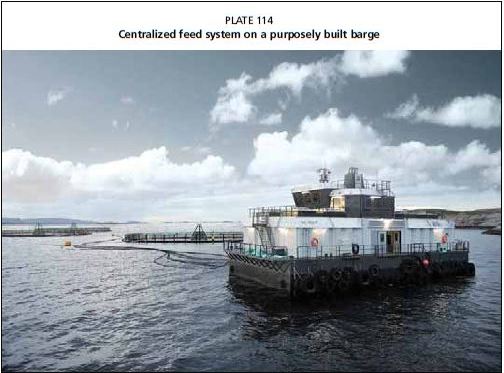8. Fish feeding
Feeding is the most important management task to optimize, this is necessary in order to increase the efficiency of the production process.
The primary objective for most fish farms is to produce high-quality fish for the lowest cost. Feed typically accounts for 50-75 percent of the operating costs in an efficient farm. If feed costs are less than this percentage, it suggests that the other costs are too high and there are inefficiencies in the operations.
The different cages within the grow-out site will require different feeding procedures. Poor feed management can result in:
increased production costs (higher FCR, longer grow-out cycle, higher management costs, etc.);
higher environmental impact from uneaten feed.
If not stored in silos, feed must be stored in a warehouse, where the following characteristics should be ensured:
Warehouse should be dedicated exclusively to feed storage.
Low humidity (feed must be kept dry). Temperatures should not exceed 40 °C.
Pest-free.
All surfaces must be cleanable.
• Entry restricted to authorized staff only.
The feed warehouse must also have some physical features to facilitate feed handling, such as:
? accessible to a forklift,
? large enough to permit the movement of pallets.
The feed storage should be organized in order to give priority to the "older" feed. A mnemonic saying is "first in, first out". This means that when a new order of feed is delivered, the older feed should be moved to where it will be available for ready use and not stored behind the new feed.
Silos are worth considering for bulk storage if loose feed is to be used on the farm. Silos facilitate the feed handling and distribution, but require a larger investment in terms of feeding equipment, because of the higher level of mechanization needed for moving, quantifying and distributing the feed.
If a centralized feed system is not used, then a dedicated feed boat (or boats) should be considered. The size, number and characteristics of the feed boats depend on the farm size, production and feeding strategies. The loading capacity of the feed boats must be determined according to the peak needs of feed to be distributed.
Logistics (jetty, pier, harbour) must also be considered for feed loading. Easy boat- loading facilities will simplify this operation and reduce the time and costs of the whole feeding activity.
Feed requirements and feed conversion efficiencies vary with changing environmental conditions (oxygen, temperature, water quality, current speed, light intensity, day length). Feed utilization also varies with diet quality and physiological factors of the fish, such as age/size, life stage, stress level and endogenous biorhythms. All of these factors contribute towards uncertainty regarding the precise amount and correct timing of feeding. This might lead to underfeeding or overfeeding of stock, and can result in poor economic performance of the farming operation.
To determinate the daily feed rate (Figure 52), expressed as a percentage of body. weight per day, the main parameters to be considered are:

? fish size;
water temperature;
feed composition (nutritional requirement). Feeding tables (see Table 35) are usually available from the feed manufacturer for each commercial feed type and species. These tables should be used as a reference to estimate the actual daily feed rate. However, other factors should be considered and the feeding rate adjusted accordingly. These factors include:
fish appetite;
? dissolved oxygen levels (current, and presence/absence of fouling on the net);
? diseases;
?sea condition;
? stressing events (handling, harvest, etc.).
Each feeding table, applicable to a specific feed and species (example gilthead seabream in the case of Table 35), indicates the suggested amount of feed that should be distributed to the fish stock, along with information on the more appropriate pellet size to use. The values in the table are to be considered as a percentage of the biomass to be fed.
TABLE 35
Example of a daily feeding table as a percentage of live body weight
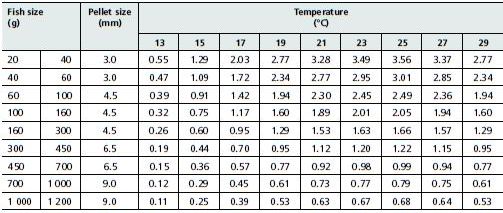
Source: Biomar feeding tables (adapted).
Example:
Parameters: batch of 100 000 fish, ABW = 150 g (15 000 kg of biomass), water temperature 23 °C.
Suggested daily feed quantity = 15 000 x 2.01% = 301.5 kg; pellet size: 4.5 mm.
Larger fish should be fed larger pellets, which will help ensure the best possible FCR As the fish grow and require larger pellets, the substitution to larger feed should be done smoothly, over a period of about one month. Both the small and the large pellet sizes should be provided during this period, with the amount of smaller feed decreasing, and the amount of the larger pellet size gradually increasing (Figure 53). This will allow the fish to adapt to thenew feed size. The smaller fish in the cohort will have some additional time to increase their size so that they can then ingest the larger pellets. When feeding, larger pellets should be distributed first, followed by the smaller pdlets.
A datasheet should be used to track the feeding for each cage. This datasheet should include:
Feed rate, expressed in kilograms and/or in number of bags.
Feed type, including brand/name and pellet size.
Actual distributed feed should be recorded, including the fish appetite and behaviour. Thefeed ID batch number (Figure 54) must also be recorded to ensure traceability of the product throughout the entire cycle.
FEEDING SYSTEMS
The development of efficient equipment and feeding routines and techniques is a priority to enhance technical and financial success, especially because feed accounts for such a large percentage of the operating budget. In larger cage systems, the choice of feeding strategies and feeding systems is one of the main operational issues. Investments in proven and effective feeding systems should, therefore, be quickly recovered.
Efficient feeding can also reduce environmental impacts. When a cage farm is in a relatively exposed site, the safe and reliable operation of feeding systems becomes particularly important.
Critical factors to be considered for the kind of feeding system used on a farm are:
labour costs, ease of operation;
species being farmed;
scale and type of farm operation;
scale of holding facilities;
type and quantity of feed;
farm feeding strategies;
exposure, reliability;
effectiveness of food distribution into the holding system;
amount of feed that can be delivered in a single feeding event.

The most common options for feed distribution are hand feeding, feed cannons, automatic feeders and centralized automatic feeders (see Plates 103-110). Each of these is treated separately in the following sections.
Farm staff should pay attention to several different aspects:
• Currents: feed should be distributed from the up-current side of the cage.
Wind: can blow the feed out of the cage. Fish appetite: should be closely monitored, and feed distribution rate should be adjusted accordingly.
• Induced currents: while feeding, fish can often produce a circular current.
• Type of distributed feed: a large amount of bags in the boat can lead to confusion and mistakes by workers.
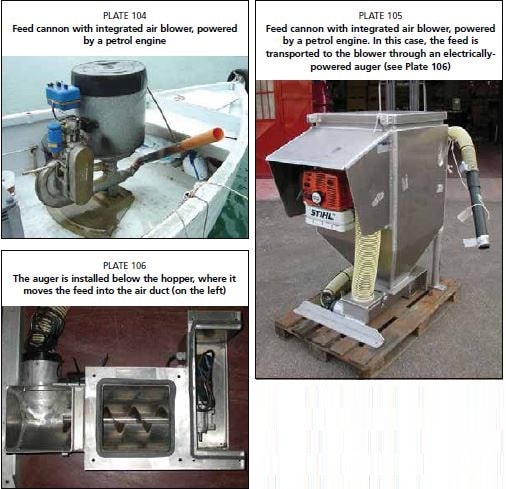
bags in the boat can lead to confusion and mistakes by workers.
Hand feeding
The principal advantage of hand feeding is that farmers can closely monitor the appetite of their fish and, consequently, can adjust the amount of food provided. Hand feeding also increases the farm workers’ attention to fish behaviour, which can signal possible disease outbreaks or other problems at an earlier stage.
Hand feeding is labour-intensive and time-consuming. Therefore, it may be very difficult on large farms, or expensive in terms of labour costs.
Hand feeding is to be preferred when juveniles are first introduced into the cage to ensure a better monitoring of feeding behaviour and a better distribution of feed at this critical early stage. Moreover, small size pellets can be easily damaged in automatic feeding equipment.
Results from hand feeding depend upon staff reliability and diligence.
Hand feeding may be difficult in large cages and the advantages of hand feeding are minimized in case of bad visibility.
Feed cannons
Feed cannons reduce the manual work involved with hand feeding. This can be considered a semi-automatic feeding system; the feed is often delivered by hand into the feed cannon, while the distribution is mechanized.
The simplest systems consist of a small feed hopper (50 litres) fitted with an air blower (Plates 104–106) or water pump (Plates 107 and 108) powered by a diesel,
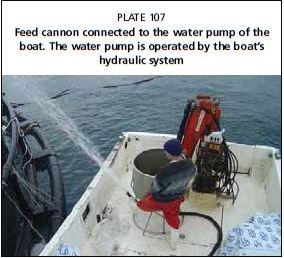

gasoline or hydraulic motor that distributes the feed. Depending on the size of the motor, the feed spread can extend up to 30 m.
Feed distribution capacity usually varies between 25 and 150 kg/minute.
Mobile cannon feeders are available in a wide range of sizes. Most of them can be operated by a single person.
Feed cannons have similar issues as hand feeding (currents, wind, fish appetite, etc.). Machine maintenance and fuel supply are additional aspects that must be taken into consideration. Feed cannons can also be installed in purposely-built feeding boats (Plate 109) usually constructed in fibreglass or HDPE. The size of the feed delivery vessel depends on the amount of feed (usually in the form of dry pdlets) that has to be delivered.
Automatic feeders
Automatic feeders are fully automated systems that deliver a set dose of feed to a specific cage at designated times. They generally have three main components:
? feed hopper,
a distributing and dosing device,
? a timing device.
There is a wide range of brands and models available. They come in different sizes and capacities, and have various means of dosing and distribution mechanisms. Plate 111 shows an example of a floating automatic feeder.
Electrical or battery-operated auomatic feeders are controlled by timers that regulate the duration of feeding and the time interval between feedings. A single control unit can be used for an individual feeder, or a central control system can operate multiple feeders.
This kind of equipment is usually not suitable for installation in very exposed offshore sites as the usually light equipment items are not designed to withstand rough
seas.
Centralized feeding systems
A centralized feeding system serves many cages at once from a single location where food is stored and delivered. These systems have an economy of scale, and as the average sizes of aquaculture units has grown, so the pressure for efficiency has increased and subsequently the feeding systems have developed greater capacity. These systems also afford the farmer greater control and improved monitoring.
An automatic feeding system generally consists of: bulk feed storage modules (silos or floating barge) (see Plate 110), blower unit, rotary valves, feed distribution system and feeder control system (Plates 111–114).
Feed is stored in one or more central silos, and from there it is moved into a dosing unit through an auger (see Plate 106), and then transferred to an injector unit. From there, it is blown through the main feed transport pipe and then through a distribution valve and individual feed pipes to its destination cages (see Plates 112 and 113).
Centralized feeding systems greatly reduce the amount of labour required for feeding (which is traditionally very labour-intensive), but they also have a high capital cost and may not be suitable for sites that are widely spread out or far offshore.
Platform-based systems with large floating silos are increasingly being used for offshore cage sites (Plate 114).
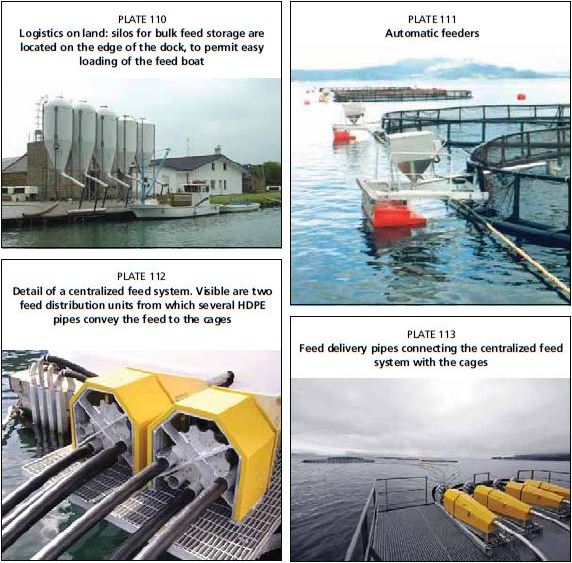
Centralized feeding systems consist of the following components:
Feed silos store the feed and are available in various capacities. They must be corrosion-resistant. Operator safety and ease of feed transfer are key elements to be considered.
Air blowers move the feed through the lines and may be electric, diesel or hydraulic powered.
Rotary valves measure the feed from the silo while isolating the hopper from the air stream. Speed of rotation is either fixed or variable. A variable speed control regulates the amount of feed that is delivered into the distribution pipe. Ease of access is important as these valves need regular maintenance.
? Distribution systems (or manifolds) provide several feed outlets from a single inlet. This makes it possible to feed several cages or to use multiple feed outlets in one larger cage.
Feed delivery pipes: Accurate positioning of the feed delivery pipes minimizes feed pellet damage. Delivery pipes are mostly made of HDPE. High temperatures (>50 °C) considerably reduce the strength and abrasion resistance of the pipe. ? Feeder control systems are operated by computer and continuously monitor the status of the system.
These systems are all computer-controlled. Their value is greatly enhanced with feedback controller systems or appetite monitoring systems that monitor the actual feed intake of the fish.
There are several type of appetite monitoring systems, including video cameras and pellet counters.
Underwater video cameras can be installed inside each cage. The video signal is transmitted to a monitor control unit (a screen), and personnel in charge of monitoring the feeding operations can check whether feed wastage is occurring, and can reduce the feed rate accordingly. This system relies on operator diligence and on water clarity.
